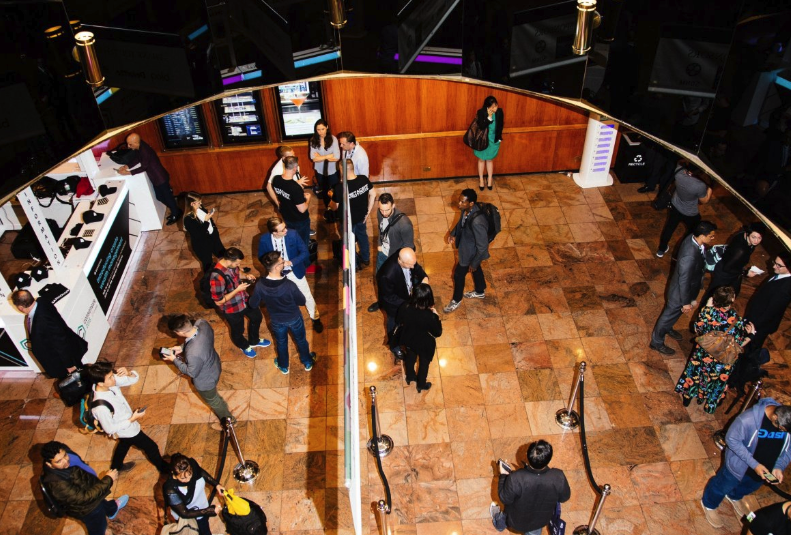Crypto-obsessed at the Consensus conference carry a sense this was the dot-com boom all over again.
Crypto-obsessed at Consensus conference carry a sense this was the dot-com boom all over again
By Alison Sider and Ben Eisen, May 16, 2018
Seth Kaye, a pink-haired designer, arrived in New York for the Consensus crypto conference this week, hoping that someone would talk to him about his idea to fund solar projects with a digital currency.
What he found was a mix of “cool techie people” and “greedy assholes”—though he did eventually run into someone who might help along his project.
The price of a bitcoin has dropped more than 50% since December, but enthusiasm for cryptocurrencies and related projects has hardly been dented, judging by the throngs that descended on the New York Hilton, where the fourth annual conference took place.
Bankers and accountants found their way into the mix. And of course, there were droves of people pitching initial coin offerings, a means of raising money by issuing digital tokens that has attracted heavy scrutiny from regulators.
As the conference opened Monday, lines snaked through the Hilton; some participants said they waited as long as two hours to get in. Tickets started at $1,000, but some paid as much $3,000 at the door. That didn’t seem to deter the crypto-obsessed—8,300 people attended, up from 2,700 last year.
All three floors were wall-to-wall people, with sessions such as “Boosting Blockchain Together” and “Brands, Seals and Crypto Collectibles.”
Throughout, there was a healthy dose of glitz and sense that this was the dot-com boom from the late 1990s all over again. One booth hocked “crypto jewelry,” including an $8,700 gold Super Bowl-size ring with the bitcoin logo. Outside, three Lamborghinis hugged the curb, a symbol for those who made big money in bitcoin.
“We thought it would be a cheeky way of getting our name out there,” said Greg Dwyer, a spokesman for the virtual exchange BitMEX, which rented the cars and said the move was a spoof on the obsession with Lambos.
“Some of my friends are millionaires now, but they’re down to earth,” said Codey Vargas of his compatriots who were early crypto investors. Mr. Vargas was talking to people about a TV show he was working on called Sharkchain, a play on Blockchain, the technology that underpins bitcoin.
At the end of the days, the crypto crowd lined up behind velvet-rope lines around Manhattan to get into after-parties. Some invites were hard to get: Greg Rempe, who provides tech services for blockchain companies, said he didn’t make the cut for one event because he didn’t meet the minimum investment threshold.
Bankers and other traditional business people got the cold shoulder, with many in the crypto world viewing them as graybeards.
“They don’t want to talk to me,” said Ville Sointu, a banker from Finland who had flown in for the conference. On a night when the rapper Snoop Dogg was performing at a party, a hot ticket in crypto land, he was at an afterparty with no live musical performance.
Earlier, Genesis Mining had poked fun at the banking industry’s resistance to cryptocurrencies by staging a fake protest, with 50 to 100 actors stationed outside the Hilton chanting “bitcoin has got to go.”
“This protest is representative of what will happen to those industries and companies that fail to understand times have changed,” said Genesis Chief Executive Marco Streng.
Over the three days, many took interest in the attendance of federal regulators, which have been vague so far about how they plan to police the industry.
After giving a speech urging more clarity on a cryptocurrency known as ether, it took Brian Quintenz of the U.S. Commodity Futures Trading Commission about 20 minutes to get out of the crowded main ballroom.
Those jostling for his attention included attendees who wanted to know more about the CFTC’s approach to cryptocurrencies, and a few who just wanted to shake his hand, including one man with a 2-foot braided ponytail.
By the tail end of the conference, not everyone was convinced of the future of crypto and all the projects coming out of it. Michael Landau, an attendee who said he was deciding whether or not to get into the space hadn’t made up his mind. “There’s a tremendous amount of energy and excitement,” he said. “But how much is real? I can’t tell you.”
—Gabriel T. Rubin contributed to this article.
